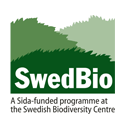Click on images to enlarge
/thumbs/psidium_guajava7_sml.jpg)
mature fruit (Photo: Sheldon Navie)
/thumbs/psidium_guajava6_sml.jpg)
immature fruit (Photo: Sheldon Navie)
/thumbs/psidium_guajava45_sml.jpg)
close-up of flowers with numerous stamens (Photo: Sheldon Navie)
/thumbs/psidium_guajava4_sml.jpg)
paired leaves with numerous prominent veins (Photo: Sheldon Navie)
/thumbs/psidium_guajava13_sml.jpg)
bark on main trunk (Photo: Sheldon Navie)
/thumbs/psidium_guajava12_sml.jpg)
older stem and leaf undersides (Photo: Sheldon Navie)
/thumbs/psidium_guajava1_-_SH_sml.jpg)
close-up of seeds (Photo: Steve Hurst at USDA PLANTS Database)
Scientific name
Psidium guajavaL.
Synonyms
Guajava pyrifera (L.) Kuntze, Myrtus guajava var. pyrifera (L.) Kuntze, Myrtus guajava (L.) Kuntze, Psidium aromaticum, Psidium cujavillus Burm. f, Psidium pomiferum L., Psidium pumilumVahl
Common names
Guava, lemon guava, mpera (Kiswahili), mubera (Kikuyu), mupeera (Luganda)
Family
Myrtaceae
Origin
This species has been cultivated for a long time; therefore its exact native range is somewhat obscure. However, it is thought to be native to tropical and subtropical America.
Naturalised distribution (global)
Locations within which Psidium guajava is naturalised include Australia, New Zealand, south-eastern USA, tropical and temperate Asia, tropical and southern Africa and many oceanic islands with warm climates.
Introduced, naturalised or invasive in East Africa
Psidium guajava is invasive in parts of Kenya (Global Invasive Species Database), Tanzania (Dawson et al. 2008, Global Invasive Species Database and Tropical Biology Association 2010) and Uganda (A.B.R. Witt pers. obs.).
Habitat
Agricultural areas, forest edges, natural forests, riparian zones (banks of watercourses), ruderal/disturbed, scrub/shrublands in higher rainfall areas.
Description
Psidium guajava is a shrub or small tree usually growing 1-6 m tall, but occasionally reaching 10 m in height.
The older stems are covered in a smooth, light reddish-brown, bark that peels off in flakes. This sometimes gives the trunks a mottled appearance, because the newly revealed bark is somewhat greenish-brown in colour. Younger stems are greenish in colour, hairy (pubescent), and somewhat four-angled (quadrangular).
The simple leaves are oppositely arranged along the stems and are borne on short stalks (petioles) 4-10 mm long. The leaf blades (7-15 cm long and 3-7 cm wide) are somewhat oval in shape (ovate-elliptic or oblong-elliptic) with rounded or pointed tips (obtuse or acute apices) and rounded (obtuse) bases. They have hairy (pubescent) undersides (especially when young), entire margins, and are generally dull green in colour. Each leaf has a prominent central vein (midrib) and 10-20 pairs of side veins (lateral veins) that are also relatively obvious.
The flowers are usually borne singly in the upper leaf forks (axils). These flowers are about 25 mm across and are borne on a hairy stalk (pubescent peduncle) 1-2.5 cm long. Each flower has four or five green sepals (6-15 mm long) that are fused together at the base and four or five white petals (10-20 mm long). They also have large numbers (200-250) of small white stamens (6-10 mm long) and a style (6-12 mm long) topped with a stigma.
The fruit is either rounded (globose), egg-shaped (ovoid) or pear-shaped (pyriform) and turns from green to yellowish in colour as it matures. These berries (2.5-10 cm long) are crowned with the remains of the persistent sepals (calyx lobes) and have a juicy pink, white or yellowish coloured pulp containing numerous seeds. The seeds are yellowish in colour and kidney-shaped (reniform). Both planted and wild trees are used for fruit which aids their spread.
Reproduction and dispersal
This species reproduces mainly by seed, but it can also reshoot from stumps and produce suckers from near the base of the trunk. The seeds are mainly dispersed by fruit-eating birds and bats, as well as other animals and people.
Similar species
Psidium guajava may be confused with Psidium guineense (Brazilian guava) and Psidium cattleianum (strawberry guava). These species can be distinguished by the following differences:
- P. guajava has hairy (pubescent) younger stems that are four-angled in cross-section (quadrangular) and relatively large yellow fruit (2.5-10 cm long). Its flowers are usually borne singly (occasionally in threes) in the leaf forks (axils) and its somewhat hairy (pubescent) dull green leaves have 10-20 pairs of prominent side veins (lateral veins).
- P. guineense has hairy (pubescent) younger stems that are almost rounded in cross-section (sub-cylindrical) and relatively small yellow fruit (1-2.5 cm long). Its flowers are usually borne in threes (occasionally singly) in the leaf forks (axils) and its hairy (pubescent) dull green leaves have 6-10 pairs of side veins (lateral veins).
- P. cattleianum has hairless (glabrous) younger stems that are rounded in cross-section (cylindrical) and relatively small purplish-red or yellow fruit (2-4 cm long). Its flowers are borne singly in the leaf forks (axils) and its hairless (glabrous) glossy green leaves have 6 or 7 pairs of side veins (lateral veins).
Economic and other uses
Psidium guajava is grown for its fruit which upon ripening, the guava becomes soft and juicy. It may be eaten fresh, made into a juice or nectar contain fruit pulp, or made into preserves, jam, jelly, or paste. Guava is an excellent source of C vitamin. Its wood can be used to make poles, fenceposts and tool handles, in handicrafts and for charcoal and firewood.
Environmental and other impacts
Psidium guajava can have a big impact on native species, invading disturbed, and to a lesser degree undisturbed, sites where it can form dense thickets which can exclude native vegetation and reduce its regeneration.
P. guajava has been included in the Global Invasive Species Database (GISD 2010). It has been listed as a Category 2 invader in South Africa (invaders with certain qualities, e.g. commercial use or for woodlots, animal fodder, soil stabilisation, etc. These plants are allowed in certain areas under controlled conditions).
Management
The precise management measures adopted for any plant invasion will depend upon factors such as the terrain, the cost and availability of labour, the severity of the infestation and the presence of other invasive species. Some components of an integrated management approach are introduced below.
The best form of invasive species management is prevention. If prevention is no longer possible, it is best to treat the weed infestations when they are small to prevent them from establishing (early detection and rapid response). Controlling the weed before it seeds will reduce future problems. Control is generally best applied to the least infested areas before dense infestations are tackled. Consistent follow-up work is required for sustainable management.
Small plants can be removed by hand. Larger plants can be uprooted but it is labour intensive. Various chemicals can be used to control Psidium guajava through basal bark applications and cut stump applications. When using any herbicide always read the label first and follow all instructions and safety requirements. If in doubt consult an expert.
Possibilities for biological control of this species in the Galapagos Islands are being investigated (A.B.R. Witt pers. comm.). Any biological control programme for a species such as this which is grown on a large scale is likely to engender conflicts of interest.
Legislation
Not listed as a noxious weed by the state or governments in Kenya, Tanzania and Uganda.
References
Dawson, W., Mndolwa, A.S., Burslem, D.F.R.P. and Hulme, P.E. (2008). Assessing the risks of plant invasions arising from collections in tropical botanical gardens. Biodiversity and Conservation 17(8): 1979-1995.
GISD (2010). Global Invasive Species Database online data sheet. Psidium guajava (tree, shrub). www.issg.org/database. Accessed March 2011.
Henderson, L. (2001). Alien weeds and invasive plants. A complete guide to declared weeds and invaders in South Africa. Plant Protection Research Institute Handbook No. 12, 300pp. PPR, ARC South Africa.
Tropical Biology Association (2010). Usambara Invasive Plants - Amani Nature Reserve - www.tropical-biology.org/research/dip/species.htm.
Editors
Agnes Lusweti, National Museums of Kenya; Emily Wabuyele, National Museums of Kenya, Paul Ssegawa, Makerere University; John Mauremootoo, BioNET-INTERNATIONAL Secretariat - UK.
Acknowledgments
This fact sheet is adapted from The Environmental Weeds of Australia by Sheldon Navie and Steve Adkins, Centre for Biological Information Technology, University of Queensland. We recognise the support from the National Museums of Kenya, Tropical Pesticides Research Institute (TPRI) - Tanzania and Makerere University, Uganda. This activity was undertaken as part of the BioNET-EAFRINET UVIMA Project (Taxonomy for Development in East Africa).
Contact
BioNET-EAFRINET Regional Coordinator: [email protected]












